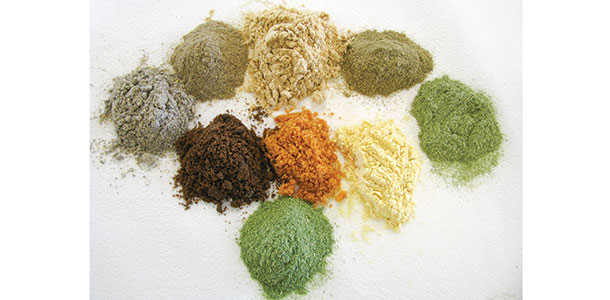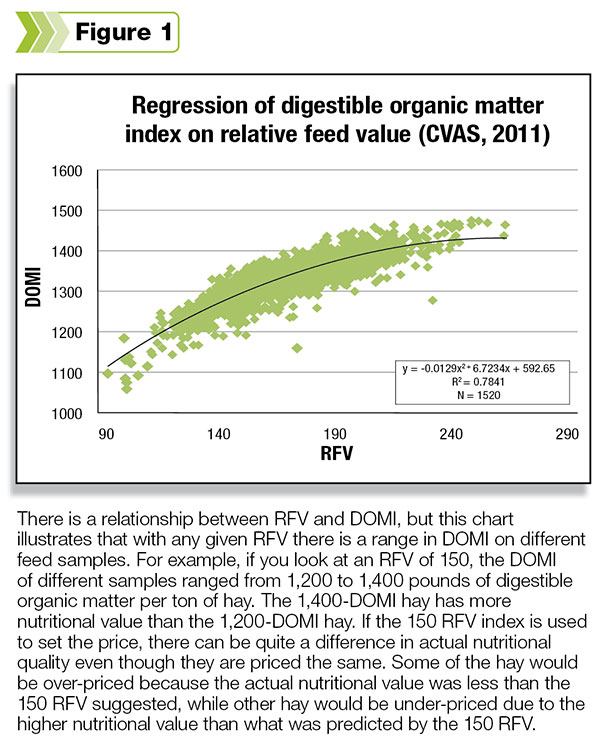Optimum performance in a dairy herd requires high-quality feed. Hay is often tested for nutrient levels before purchase, or when determining how to best feed or supplement homegrown hay. Some of the common tools used for hay analyses include analytical tests for crude protein (CP) and fiber components – which are stated as acid-detergent fiber (ADF) and neutral-detergent fiber (NDF). Many dairy producers and hay growers also use an index system such as relative feed value (RFV) to compare forages.
The digestible organic matter index (DOMI) is the newest tool that can be used by dairies to rank forages by quality.
Lynn Van Wieringen, Ph.D., ruminant nutritionist and lab manager at Ag Health Laboratories in Sunnyside, Washington, says their lab recently began using DOMI, an index developed by Cumberland Valley Analytical Services in Maryland. “We feel that this newer index works better and more accurately reflects the actual feed quality,” she says.
Advantages of DOMI
Indexes are formulas nutritionists come up with to get one number that can help producers compare feeds. The two standards in the industry have been RFQ (relative feed quality) and RFV (relative feed value).
“The RFQ is a good equation but more expensive and time-consuming (taking longer to get the test results) because it requires additional nutrient analysis,” says Van Wieringen.
RFV has been the most commonly used index, but it has some major limitations. “It merely looks at ADF and NDF but doesn’t consider digestibility of the fiber. It also doesn’t look at CP. Test results can be skewed by ash content (dust and soil contamination) in the hay, lowering the RFV. A large portion of the ash will show up as fiber,” she says.
In many regions of the country, there is a certain amount of ash or dust in forage, which makes the RFV index less accurate. Traffic along a gravel road on a windy day can spread clouds of dust over large areas of adjacent hayfields.
Rain can splatter mud onto the plants. Some of the newer rakes tend to pick up more dirt when windrows are raked together. All of these situations lead to higher ash content in forages, which may put them at a lower RFV even though the nutrient quality may be excellent.
“We’ve had a lot of interest in this new DOMI index because it removes the ash and the indigestible fiber from the calculation. Thus, it evaluates the quality more accurately than RFV does because it looks at the digestible organic matter, which will contain all the other nutrients available in the feed such as crude protein and readily available carbohydrates,” she says.
Van Wieringen feels that the DOMI will be one of the easier indexes for people to use. It can be difficult for people who don’t have a lot of nutrition background to interpret and understand all the different nutrient values in a typical feed analysis.

Those values are all important, but the DOMI simplifies it into a value everybody can understand. “You don’t have to have a degree in nutrition to understand the number that tells us whether it’s good-quality hay or not,” she explains.
Their dairy clients are becoming comfortable about the numbers and knowing where good hay ranks on the standards compared to lower-quality hay. The DOMI tells you how many pounds of digestible organic matter there are in a ton of hay.
“So far, with samples that have been run at Ag Health Labs, alfalfa hay has been averaging about 1,200 for DOMI,” says Fred Muller, DVM (owner of Ag Health Laboratories). “There is a wide range on the samples, but if hay is below that average, you know it’s not as good. If it’s in the 1,300 range, you know it is higher quality,” says Muller.
“We are now able to report the DOMI index in any of the forage packages that we offer – for hay, grasses and alfalfa, legumes, cereal-grain hays – but it is not applicable for corn silage or anything that has much grain content.
The starch levels in those will skew it. But it works for all the grasses and legumes. There is a bit of a different range across forage types, so a person needs to be familiar with what the range would be on the type of hay being tested,” he explains.
“There are different NDF levels between grasses and alfalfa, for instance. You need to be comparing the same hay type to determine the quality of one batch versus another. You can get some idea, comparing across categories (grass versus alfalfa for instance); however, you should stay within a category to compare them,” Muller says.
How dairies are using DOMI
Van Wieringen says the DOMI is becoming a very useful tool for dairy clients. “It can be used when purchasing hay, haylage or silage (but not corn silage).
When evaluating multiple stacks of hay prior to purchase, the DOMI (as-is pounds per ton) can be helpful to quickly assess quality and identify which stacks are higher quality (higher DOMI) versus lower quality (lower DOMI). This information can be used as a selection tool in determining which stacks to purchase and also to help determine the price,” she explains.
“It can be used to compare hay crop forages with higher moisture content (such as alfalfa haylage and grass silage) to assess quality quickly. However, when comparing multiple high-moisture hay crop forages, it is necessary to evaluate the DOMI on a hay-equivalent basis (90 percent moisture).
Our lab is currently reporting DOMI on both “as-is” basis (for hay comparisons) and “hay-equivalent basis” (for high-moisture hay crop forage comparisons),” she says.
The ability to rank the quality of multiple high-moisture hay crop forages at the same time may be useful prior to harvesting and also during the feeding stage.
 “Prior to harvest, it can be used to decide the order in which to harvest fields. If a person has the interest and time available to collect pre-harvest samples by field, variety, age of stand, etc., the samples could be submitted to the lab and analyzed within 24 to 48 hours (the time depending on moisture level of the forage when it arrives at the lab) to determine the nutrient content and calculate a DOMI.
“Prior to harvest, it can be used to decide the order in which to harvest fields. If a person has the interest and time available to collect pre-harvest samples by field, variety, age of stand, etc., the samples could be submitted to the lab and analyzed within 24 to 48 hours (the time depending on moisture level of the forage when it arrives at the lab) to determine the nutrient content and calculate a DOMI.
This tool can help dairy farmers schedule the harvest and help determine the order in which to harvest fields – based on the DOMI, looking at hay equivalent in pounds per ton,” says Van Wieringen.
This index could also be used when purchasing high-moisture hay crop forages such as alfalfa haylage or grass silage.
“DOMI (hay-equivalent basis) can be used as an indicator of quality. Based on where the DOMI falls in a ranking system (higher than average, average or lower than average for the type of forage, growing conditions, climate conditions, etc.), a price can be established based on a quality indicator (DOMI) instead of solely on moisture content – which is a common practice,” she says.
The DOMI could be used in a formula for pricing haylage, for instance, so the buyer and seller know ahead of harvest how it will be priced. “If it’s more mature or overly wet, the price paid by the dairy to the grower can automatically be adjusted based on an as-is DOMI,” she says.
In some situations, there may be opportunity to separate fields by quality (using the DOMI as a guide) during the storage phase. “For example, if you have multiple bags or bunkers available at harvest time, the higher-quality (higher DOMI) pre-harvest high-moisture hay crop forages could be stored in one structure (bunker or bag) and the lower-quality forages stored in another structure,” says Van Wieringen.
This allows for more options during feeding. “If high-moisture hay crop forages are stored based on quality, they can be fed to various groups of cattle more selectively. The highest-quality forages can be fed to high-producing lactating cows while the lower-quality (lower DOMI) forages can be fed to heifers and dry cows.” PD
Heather Smith Thomas is a freelance writer based in Idaho.
PHOTOS
TOP: Lynn Van Wieringen says the digestible organic matter index is becoming a very useful tool for dairy clients. “It can be used when purchasing hay, haylage or silage (but not corn silage).”
MIDDLE: The ability to rank the quality of multiple high-moisture hay crop forages at the same time may be useful prior to harvesting and also during the feeding stage. Photos courtesy of Heather Smith Thomas.






